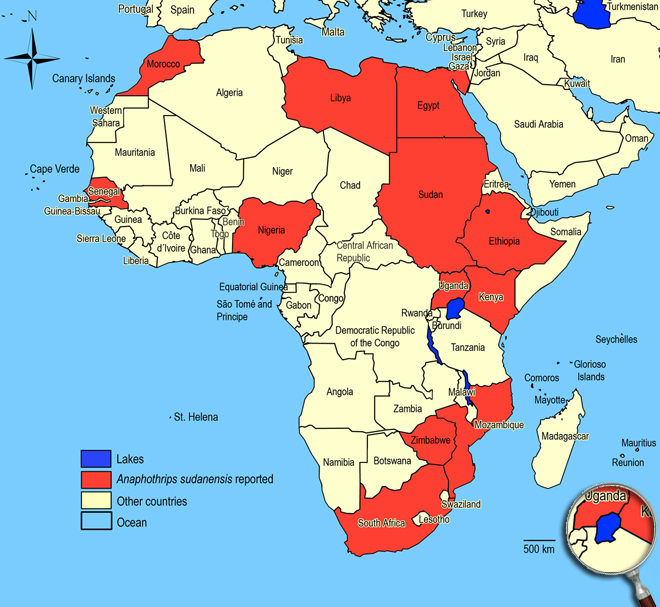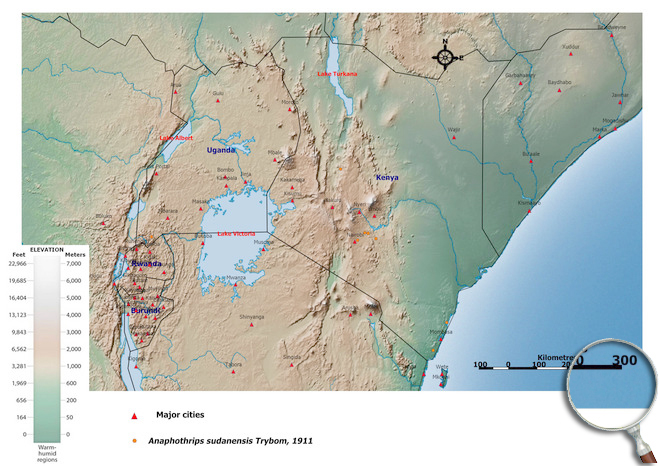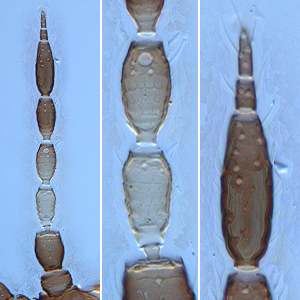Anaphothrips sudanensis Trybom, 1911
Thripinae, Thripidae, Terebrantia, Thysanoptera
Figures
Fig. 1: 8-segmented antenna, segments III and IV with forked sense cone, terminal segments VI-VIII
Fig. 2: Head dorsal with ocellar triangle
Fig. 3: Pronotum
Fig. 4: Meso- and metanotum
Fig. 5: Fore wing with dark band, distal area of fore wing
Fig. 6: Tergites I-III
Fig. 7: Tergites VIII-XI, tergite VIII with posteromarginal microtrichial comb
Fig. 8: Sternites VI and VII
Fig. 9: Bicolored female and wingless male
Introduction and recognition
Anaphothrips sudanensis is a grass feeding pest and causes damage to cereal crops. Female macropterous or micropterous; body bicolored, mainly dark brown but with abdominal segments 3-5 yellow, also antennal segments III & IV; fore wings pale but with dark cross band medially (Fig. 9). Antennae 8-segmented; segments III & IV each with short forked sense cone (Fig. 1). Head with 3 pairs of ocellar setae, pair III arise in front of ocellar triangle (Fig. 2). Head and pronotum with no long setae (Fig. 3). Metanotum with mainly equiangular reticulation at anterior, but transverse reticulated posteriorly; median pair of setae arise well behind anterior margin; campaniform sensilla absent (Fig. 4). Meso- and metasternal furca without spinula. Mid and hind tarsi 2-segmented. Fore wing, when developed, with veinal setae shorter than half of wing width; first vein with 3 setae on distal half; second vein with about 6 equally spaced setae (Fig. 5). Tergites with no lines of sculpture medially (Fig. 6); VIII with complete posteromarginal comb of long microtrichia on broadly triangular bases (Fig. 7). Sternite VII with median pair of setae arising near posterior margin (Fig. 8).
Male similar to micropterous female but legs paler and pterothorax largely yellow; tergite IX with 2 pairs of stout thorn-like setae medially; sternites III-VIII with large C-shaped glandular area.
Taxonomic identity
Species
Anaphothrips sudanensis Trybom, 1911
Taxonomic history
Anaphothrips (Neophysopus) piercei Moulton, 1936
Anaphothrips bicinctus Hood, 1925
Anaphothrips bicolor Morgan, 1925
Anaphothrips transvaalensis Faure, 1925
Euthrips citricinctus Bagnall, 1919
Anaphothrips speciosus Hood, 1919
Euthrips alternans Bagnall, 1914
Neophysopus medioflavus Schmutz, 1913
Euthrips (Anaphothrips) alternans Bagnall, 1913
Anaphothrips flavicinctus Karny, 1912
Euthrips flavicinctus Karny, 1912
Euthrips sudanensis Karny, 1912
Common name
Wheat [ear] thrips
Maize thrips
Present taxonomic position
Family: Thripidae Stephens, 1829
Subfamily: Thripinae (Stephens) Karny, 1921
Genus: Anaphothrips Uzel, 1895
Genus description
The genus Anaphothrips Uzel, 1895
Cosmopolitan, about 80 described species in this genus are normally found on plants of the grass familiy, Poaceae. Several species are quite common on many different hosts. Relationships within this genus are unclear (probably restricted to less than 40 species (Nakahara 1995). More than 40 species of this genus recognized as mainly non-grass feeders in Australia (Mound & Masumoto 2009). Members of this genus are macropterous or micropterous, with 8- or apparently 9 segmented antennae (segment VI often devided by a suture near apex), 3 pairs of ocellar setae and 2-segmented tarsi. Head and pronotum without well-developed long setae. Fore wing first vein setal row interrupted and tergite VIII with a complete posteromarginal comb of microtrichia (Mound & Marullo 1996).
Species description
Typical key character states of Anaphothrips sudanensis
Coloration and body sculpture
Body color: distinctively bicolored
Surface of head, pronotum and fore legs: without obvious or with weakly reticulate sculpture
Antennae
Form of sense cones on antennal segments III and IV: emergent and forked on segments III and IV
Number of antennal segments: 8
Antennal segment I: without any setae on dorsal apical margin
Antennal segment II: without an exceptionally long seta at the inner apex
Antennal segment II shape: symmetric
Antennal segment III shape: symmetric
Antennal segments IV and V: without a hyaline ring near the base
Antennal segment VI bears: not a remarkably dagger-shaped sensorium
Forked sense cone on antennal segment IV: scarcely extending beyond base of segment V
Length of antennal segments III and IV: antennal segment III similar in length to segment IV
Head
Head: distinctly prolonged in front of compound eyes
Distance between bases of ocellar setae III: greater than width of first ocellus
Ocellar setae I: present
Ocellar setae III: arising on anterior margin of, or in front of ocellar triangle
Ocelli: present
Length of postocular setae: not alternating short and long setae
Number of ocellar setae: 3
Prothorax
Number of pairs of long anteroangular setae: 0
Number of pairs of long posteroangular setae: 0
Number of pairs of elongate pronotal setae: 0 (1)
Pronotal blotch or internal apodeme: absent
Pronotum shape: broadly rectangular
Pronotum posteromarginal/posteroangular setae: S2 longer than S3, not equal in length
Mesothorax
Mesosternal furca: without spinula
Metathorax
Metanotal median setae: S1 behind anterior margin
Metanotum with dominant sculptured triangle medially: absent
Metasternal furca: without spinula
Metanotal campaniform sensilla: absent
Sculpture of metanotum median area: equiangular reticulations at anterior, but transverse irregular lines on posterior half
Shape of metathoracic furca: transverse, V-shaped
Wings
Fore and hind wings: present, more than half as long as abdomen (macropterous) or not longer than thorax width (micropterous)
Fringe cilia arising: from sockets
Fore wing veins: present
Fore- and hind wing surface: covered with microtrichia
Apex of fore wing: with prominent terminal setae
Fore wing anterior margin (costal vein): with setae and cilia but cilia longer than setae
Fore wing costal fringe cilia: arising at anterior margin of wing
Fore wing first vein: distinct from costal vein
Fore wing first vein setal row: incomplete, with setae not closely and uniformly spaced
Fore wing first vein number of setae on distal half: 3
Fore wing second vein setal row: complete, setae uniformly spaced
Fore wing shape: mainly parallel sided or margins run continuously towards each other
Fore wing surface: not reticulate
Fringe cilia on posterior margin near apex: distinctly wavy (undulated)
Length of fore wing costal setae at middle of wing: shorter than half of median wing width
Shape of fore wing apex: with mainly posterior margin curved to join anterior margin
Fore wing extreme apex color: pale
Fore wings: alternating bands of dark and light
Legs
Color of fore tarsi: pale or yellow, sometimes apical shaded or brown
Fore tibia: not prolonged around fore tarsus
Mid and hind tarsi: with two segments
Abdomen
Pleurotergites: not covered in microtrichia
Sternite II: with marginal setae but no discal setae
Sternites IV, V and VI: with marginal setae but no discal setae
Sternite VII median posteromarginal setae S1: arising in front of posterior margin
Sternite VII: with marginal setae but no discal setae
Craspedum on tergites IV to VI: absent
Surface of lateral thirds of abdominal tergites: without regular rows of fine microtrichia
Sculpture of tergites II to VIII: with one or without transverse lines of sculpture between median pair of setae
Tergites II to VII median setal pair: no more than 0.3 as long as median length of tergite
Tergites IV and V median setal pair: shorter than distance between their bases
Tergites V to VII: without ctenidia laterally, but sometimes with rows of microtrichia
Tergite VIII ctenidia: without paired ctenidia laterally, sometimes with irregular microtrichia
Tergite VIII posteromarginal comb of microtrichia: present and complete medially
Tergite VIII shape of posteromarginal microtrichia: long on broadly triangular bases
Tergite X: not tubular, longitudinally incomplete
Setae on abdominal tergite X: all setae slender

Similar or related species
Compared to Anaphothrips obscurus, Anaphothrips sudanensis is characterised by the sharply bicolored body, 8-segmented antennae, pale fore wings with a dark cross band medially, metanotal median area with equiangular reticulation at anterior but transverse reticulation on posterior half, tergites with no lines of sculpture medially, tergite VIII posteromarginal microtrichia are long on broadly triangular bases, and sternite VII median marginal setae arising near posterior margin. Whereas Anaphothrips obscurus has a mainly pale or yellow body color, 8- or 9-segmented antennae (segment VI partially divided), fore wings uniformly pale or weakly shaded, metanotal median area sculptured lines with mainly equiangular reticulation, tergites with transverse reticulate lines of sculpture medially, tergite VIII posteromarginal microtrichia are short on broadly triangular bases, and sternite VII median marginal setae arising well in front of posterior margin.
Anaphothrips is similar to the genus Dichromothrips, Megalurothrips, Tenothrips and Ceratothripoides in lacking tergal ctenidia even on tergite VIII, and lacking regular rows of fine microtrichia on lateral thirds of tergites. Compared to species of Anaphothrips, Dichromothrips priesneri has a head with ocellar setae I absent, a pronotum with 1 pair of long posteroangular setae and a metathorax with a well developed internal spinula and median area without any equiangular reticulation. Anaphothrips as well as Megalurothrips, Tenothrips and Ceratothripoides have 3 pairs of ocellar setae on head and a metathorax without a well developed internal spinula, but in Megalurothrips, Tenothrips and Ceratothripoides the pronotum shows 2 pairs of long posteroangular setae (Anaphothrips without elongate pronotal setae), and on tergite VIII the posteromarginal comb of microtrichia is broadly absent medially in Megalurothrips and Tenothrips (in Anaphothrips and Ceratothripoides tergite VIII with complete posteromarginal comb of microtrichia).
Biology
Life history
As with other thrips species the life cycle from egg to adult is dependent on temperature. The life cycle from the egg to the adult ranges from 11 to 28 days (Ananthakrishnan 1971). Adults may live for more than one month producing several generations in one year depending on seasonal weather.
Host plants
Grasses and cereal crops: finger millets, maize, Napier grass, rice, sorghum, sugarcane, wheat.
Weeds: Tagetes minuta.
Vector capacity
None identified, but possible mechanical distribution of phytopathogenic fungi and bacteria.
Damage and symptoms
Concentrated feeding by the larvae and adults resulting in whitening of the leaves; in extreme cases there is complete bleaching of the leaf blade (Ananthakrishnan 1971).
Detection and control strategies
-
Additional notes
-
Biogeography
In subtropical and tropical regions around the world.
Egypt (Bahtim near Cairo), Ethiopia,
Kenya, Libya,
Mozambique,
Morocco,
Nigeria (Mokwa),
Senegal (Fété Olé),
South Africa (Limpopo: Mokopane, Modimolle; Mpumalanga: Nelspruit; Gauteng: Pretoria, North West: Rustenburg, Eastern Cape: Balfour),
Sudan (Kaka), Zimbabwe.
African countries where Anaphothrips sudanensis has been reported

Occurence of Anaphothrips sudanensis in East Africa

Please click here for survey sites of all observed thrips species of Kenya, Tanzania and Uganda.
Click here for locations of Anaphothrips sudanensis in parts of East Africa.

Bibliography
Ananthakrishnan TN (1971). Thrips (Thysanoptera) in agriculture, horticulture & forestry - diagnosis, bionomics & control. Journal of Scientific and Industrial Research. 30 (3): 113-146
Bagnall RS (1913). Brief descriptions of new Thysanoptera - I. Annals and Magazine of Natural History, Zoology, Botany and Geology. (Serie 8) 12: 290-299
Bagnall RS (1919). Brief descriptions of new Thysanoptera - X. Annals and Magazine of Natural History, Zoology, Botany and Geology. (Serie 9) 4: 253-277
Bhatti JS (1999). The male genitalia of Anaphothrips sudanensis Trybom (Terebrantia: Thripidae). Oriental Insects. 33: 243-246
Faure JC (1925). A new genus and five new species of South African Thysanoptera. South African Journal of Natural History. 5: 143-166
Hood JD (1919). Two new genera and thirteen new species of Australian Thysanoptera. Proceedings of the Biological Society of Washington. 32: 75-92
Hood JD (1925). New neotropical Thysanoptera collected by C. B. Williams. Psyche. 32: 48-69
Karny H (1912). Gallenbewohnende Thysanopteren aus Java. Marcellia. 11 (2-3): 115-169
Karny H (1912). Revision der von Serville aufgestellten Thysanopteren-Genera. Zoologische Annalen. 4 (4): 322-344
Lewis T (1973). Thrips: their biology, ecology and economic importance. Academic Press Inc., London Ltd., 349 pp
Morgan AC (1925). A new genus, a new subgenus and seven new species of Thysanoptera from Puerto Rico. Florida Entomologist. 9 (1): 1-7
Moritz G (2006). Thripse. Pflanzensaftsaugende Insekten Bd. 1, (1. Auflage). Westarp, Hohenwarsleben, 384 pp. ISBN-13: 978 3 89432 891 7
Moritz G, Morris DC & Mound LA (2001). ThripsID - Pest thrips of the world. ACIAR and CSIRO Publishing Collingwood, Victoria, Australia, CDROM ISBN 1 86320 296 X
Moritz G, Mound LA, Morris DC & Goldarazena A (2004). Pest thrips of the world - an identification and information system using molecular and microscopical methods. Centre for Biological Information Technology, University of Queensland, Australia, CDROM ISBN 1 86499 781 8
Moritz G, O'Donnell C & Parrella M (2009). Pest thrips of North America. Centre for Biological Information Technology, University of Queensland, Australia, CDROM ISBN-13: 978 1 86499 940 2
Moulton D (1936). Thysanoptera of the Philippine Islands. Philippine Journal of Agriculture. 7: 263-273
Mound LA (1968). A review of R. S. Bagnalľs Thysanoptera collections. Bulletin of the British Museum (Natural History), Entomology. Supplement 11: 1-181
Mound LA & Kibby G (1998). Thysanoptera: An identification guide, (2nd edition). CAB International, Wallingford and New York, 70 pp
Mound LA & Marullo R (1996). The thrips of Central and South America: An introduction (Insecta: Thysanoptera). Memoirs on Entomology, International, Vol. 6. Associated Publishers, Gainsville, 487 pp
Mound LA & Masumoto M (2009). Australian Thripinae of the Anaphothrips genus-group (Thysanoptera), with three new genera and thirty-three new species. Zootaxa. 2042: 1-76
Nakahara S (1995). Review of the nearctic species of Anaphothrips (Thysanoptera: Thripidae). Insecta Mundi. 9: 221-248
Nakao S, Omote Y, Yamada H, Matsumoto K, Nakashima A & Yabu S (2001). Body colour and wing length variation within a local population of Anaphothrips sudanensis (Thysanoptera: Thripidae). Japanese Journal of Entomology, New Series. 4 (1): 11-19
Palmer JM (1990). Identification of the common thrips of Tropical Africa (Thysanoptera, Insecta). Tropical Pest Management. 36 (1): 27-49
Palmer JM, Mound LA & Du Heaume GJ (1989). 2. Thysanoptera, 73 pp. In Betts CR [ed.]. CIE Guides to insects of importance to man. CAB International, Wallingford, Oxon, UK
Pitkin BR (1978). A revision of the Australian species of Anaphothrips Uzel (Thysanoptera: Thripidae). Australian Journal of Zoology. 26 (2): 349-371
Priesner H (1964). A monograph of the Thysanoptera of the Egyptian deserts. Publications de ľInstitut du Desert d´Égypte (1960). 13: 1-549
Schmutz K (1913). Zur Kentniss der Thysanopterenfauna von Ceylon. Sitzungsberichte der Kaiserlichen Akademie der Wissenschaften, Mathematisch-Naturwissenschaftliche Klasse, Abteilung I. Biologie, Mineralogie, Erdkunde. 122 (7): 991-1089
Stannard LJ (1968). The Thrips, or Thysanoptera, of Illinois. Illinois Natural History Survey Bulletin. 29 (4): 215-552
Trybom F (1911). Physapoden aus Ägypten und dem Sudan. Results of the Swedish Zoological Expedition to Egypt and the White Nile (1900-1901) under the direction of L. A. Jagerskiold. 19: 1-16
Umar M, Akram W, Ali B, Tariq M & Shah NA (2003). Description of three genera (Thripidae: Thysanoptera) from Azad Jammu and Kashmir (Pakistan). Online Journal of Biological Sciences. 3 (5): 524-534
zur Strassen R (1960). Catalogue of the known species of South African Thysanoptera. Journal of the Entomological Society of Southern Africa. 23 (2): 321-367
zur Strassen R (1968). Ökologische und zoogeographische Studien über die Fransenflügler-Fauna (Ins., Thysanoptera) des südlichen Marokko. Abhandlungen der Senkenbergischen Naturforschenden Gesellschaft. 515: 1-125
zur Strassen R (1968). New records of South African Thysanoptera with description of a new Phlaeothripid genus. Journal of the Entomological Society of Southern Africa. 31 (2): 365-372
zur Strassen R (2003). Die terebranten Thysanopteren Europas und des Mittelmeer-Gebietes. Die Tierwelt Deutschlands und der angrenzenden Meeresteile nach ihren Merkmalen und nach ihrer Lebensweise, 74. Teil. Goecke & Evers, Keltern, Germany, 277 pp
----
Web links
Mound´s Thysanoptera pages
Thysanoptera Checklist
ICIPE Thrips survey sites
UNI Halle & Thrips sites
Thrips of California













